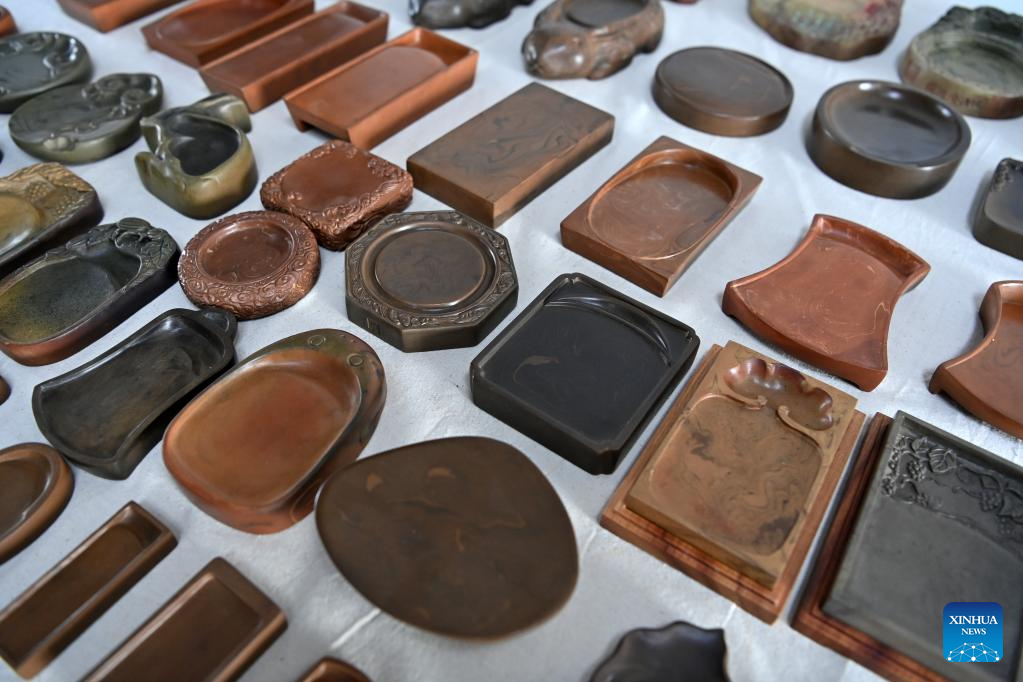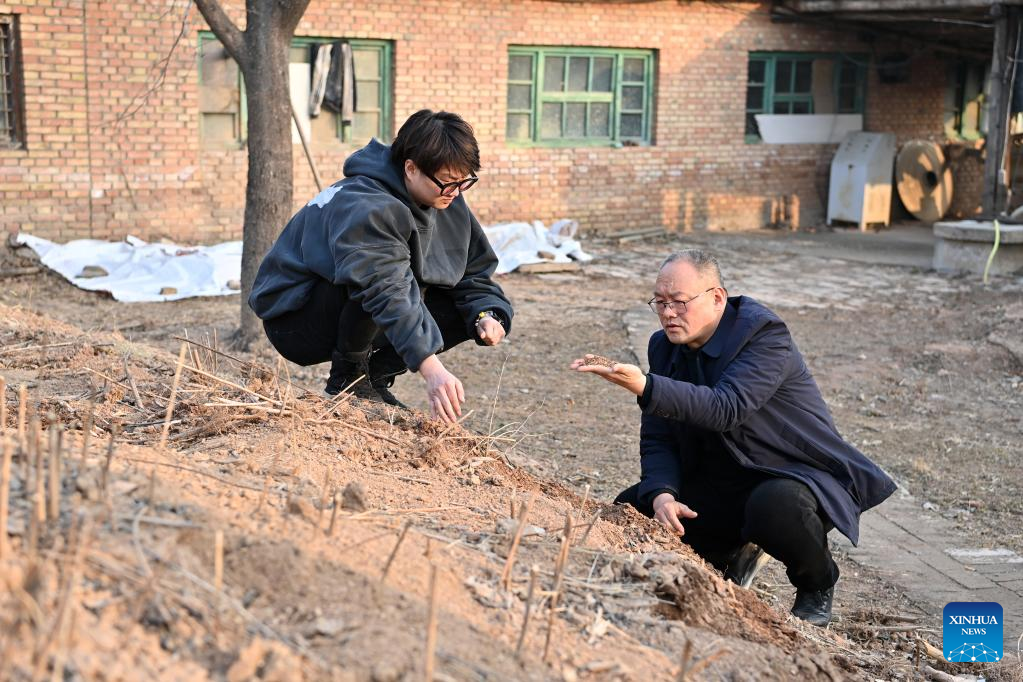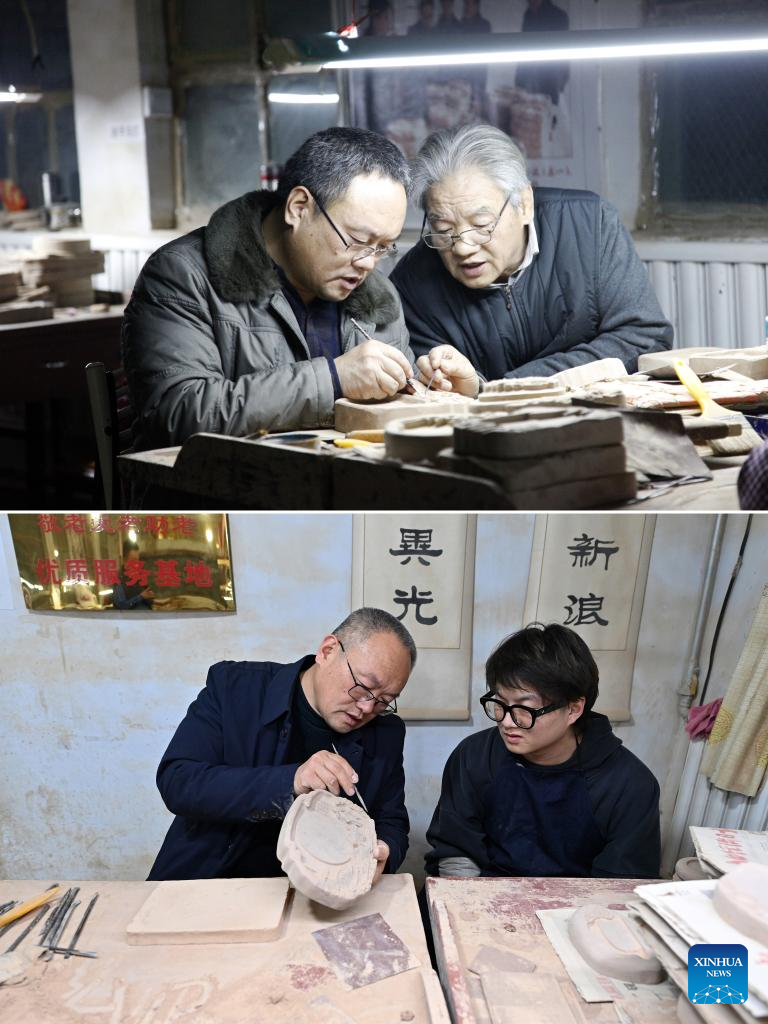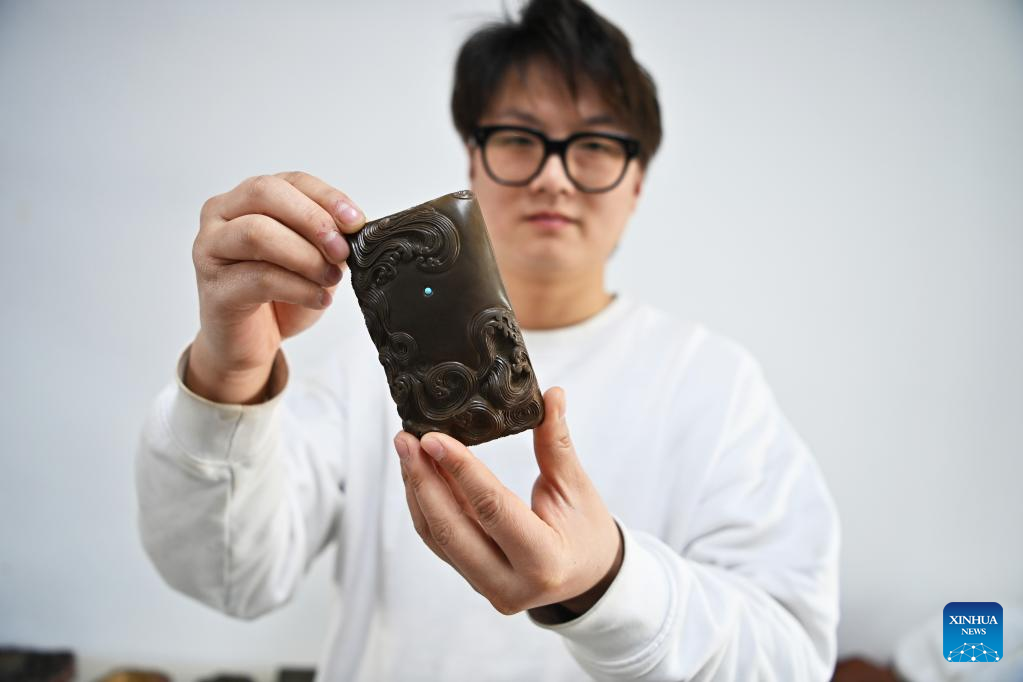|

This photo taken on Feb. 15, 2023 shows Chengni inkstones displayed at a Chengni inkstone cultural park in Xinjiang County in Yuncheng, north China's Shanxi Province. Chengni inkstone, one of the "four famous inkstones" in China, is known for its fine texture which can reduce harm done to the brush. Due to various reasons, the time-honored craft of making Chengni inkstone had once been lost and was later brought back by Lin Yongmao and his son Lin Tao in Xinjiang County. It takes over a year and more than 10 steps to make a Chengni inkstone. In 2008, the craft of making Chengni inkstone was listed as one of China's national intangible cultural heritages. As the third-generation inheritor of the craft of making Chengni inkstone, Lin Xiaolin knew the craft well since his childhood. In 2019, he innovated the production of Chengni inkstone with his knowledge on ceramics after returning from studying abroad. By controlling the temperature of the kiln, he increased the colors of Chengni inkstone from three to eight. The young inheritor also explores online sale via e-commerce and live streaming, which has brought more attention to the traditional handicraft. In the future, Lin Xiaolin plans to cooperate with universities and colleges to make Chengni inkstone more popular with stylish designs. (Xinhua/Yang Chenguang) 
Lin Xiaolin communicates with his father Lin Tao (R) on the mud choosing for making Chengni inkstone in Guangcun Village of Xinjiang County in Yuncheng, north China's Shanxi Province, Feb. 14, 2023. Chengni inkstone, one of the "four famous inkstones" in China, is known for its fine texture which can reduce harm done to the brush. Due to various reasons, the time-honored craft of making Chengni inkstone had once been lost and was later brought back by Lin Yongmao and his son Lin Tao in Xinjiang County. It takes over a year and more than 10 steps to make a Chengni inkstone. In 2008, the craft of making Chengni inkstone was listed as one of China's national intangible cultural heritages. As the third-generation inheritor of the craft of making Chengni inkstone, Lin Xiaolin knew the craft well since his childhood. In 2019, he innovated the production of Chengni inkstone with his knowledge on ceramics after returning from studying abroad. By controlling the temperature of the kiln, he increased the colors of Chengni inkstone from three to eight. The young inheritor also explores online sale via e-commerce and live streaming, which has brought more attention to the traditional handicraft. In the future, Lin Xiaolin plans to cooperate with universities and colleges to make Chengni inkstone more popular with stylish designs. (Xinhua/Yang Chenguang) 
This combo photo shows Lin Tao (L) and his father Lin Yongmao making a Chengni inkstone in Guangcun Village of Xinjiang County in Yuncheng, north China's Shanxi Province, Nov. 14, 2015 (upper) and Lin Tao (L) communicating with his son Lin Xiaolin on the craft of making Chengni inkstone in Guangcun Village, Feb. 14, 2023 (lower, photo taken by Yang Chenguang). Chengni inkstone, one of the "four famous inkstones" in China, is known for its fine texture which can reduce harm done to the brush. Due to various reasons, the time-honored craft of making Chengni inkstone had once been lost and was later brought back by Lin Yongmao and his son Lin Tao in Xinjiang County. It takes over a year and more than 10 steps to make a Chengni inkstone. In 2008, the craft of making Chengni inkstone was listed as one of China's national intangible cultural heritages. As the third-generation inheritor of the craft of making Chengni inkstone, Lin Xiaolin knew the craft well since his childhood. In 2019, he innovated the production of Chengni inkstone with his knowledge on ceramics after returning from studying abroad. By controlling the temperature of the kiln, he increased the colors of Chengni inkstone from three to eight. The young inheritor also explores online sale via e-commerce and live streaming, which has brought more attention to the traditional handicraft. In the future, Lin Xiaolin plans to cooperate with universities and colleges to make Chengni inkstone more popular with stylish designs. (Xinhua) 
Lin Xiaolin carves on a Chengni inkstone in Guangcun Village of Xinjiang County in Yuncheng, north China's Shanxi Province, Feb. 14, 2023. Chengni inkstone, one of the "four famous inkstones" in China, is known for its fine texture which can reduce harm done to the brush. Due to various reasons, the time-honored craft of making Chengni inkstone had once been lost and was later brought back by Lin Yongmao and his son Lin Tao in Xinjiang County. It takes over a year and more than 10 steps to make a Chengni inkstone. In 2008, the craft of making Chengni inkstone was listed as one of China's national intangible cultural heritages. As the third-generation inheritor of the craft of making Chengni inkstone, Lin Xiaolin knew the craft well since his childhood. In 2019, he innovated the production of Chengni inkstone with his knowledge on ceramics after returning from studying abroad. By controlling the temperature of the kiln, he increased the colors of Chengni inkstone from three to eight. The young inheritor also explores online sale via e-commerce and live streaming, which has brought more attention to the traditional handicraft. In the future, Lin Xiaolin plans to cooperate with universities and colleges to make Chengni inkstone more popular with stylish designs. (Xinhua/Yang Chenguang) 
Lin Xiaolin (R) filters the mud to make Chengni inkstone in Guangcun Village of Xinjiang County in Yuncheng, north China's Shanxi Province, Feb. 14, 2023. Chengni inkstone, one of the "four famous inkstones" in China, is known for its fine texture which can reduce harm done to the brush. Due to various reasons, the time-honored craft of making Chengni inkstone had once been lost and was later brought back by Lin Yongmao and his son Lin Tao in Xinjiang County. It takes over a year and more than 10 steps to make a Chengni inkstone. In 2008, the craft of making Chengni inkstone was listed as one of China's national intangible cultural heritages. As the third-generation inheritor of the craft of making Chengni inkstone, Lin Xiaolin knew the craft well since his childhood. In 2019, he innovated the production of Chengni inkstone with his knowledge on ceramics after returning from studying abroad. By controlling the temperature of the kiln, he increased the colors of Chengni inkstone from three to eight. The young inheritor also explores online sale via e-commerce and live streaming, which has brought more attention to the traditional handicraft. In the future, Lin Xiaolin plans to cooperate with universities and colleges to make Chengni inkstone more popular with stylish designs. (Xinhua/Yang Chenguang) 
Lin Xiaolin presents Chengni inkstones via live streaming in a studio in Xinjiang County of Yuncheng, north China's Shanxi Province, Feb. 15, 2023. Chengni inkstone, one of the "four famous inkstones" in China, is known for its fine texture which can reduce harm done to the brush. Due to various reasons, the time-honored craft of making Chengni inkstone had once been lost and was later brought back by Lin Yongmao and his son Lin Tao in Xinjiang County. It takes over a year and more than 10 steps to make a Chengni inkstone. In 2008, the craft of making Chengni inkstone was listed as one of China's national intangible cultural heritages. As the third-generation inheritor of the craft of making Chengni inkstone, Lin Xiaolin knew the craft well since his childhood. In 2019, he innovated the production of Chengni inkstone with his knowledge on ceramics after returning from studying abroad. By controlling the temperature of the kiln, he increased the colors of Chengni inkstone from three to eight. The young inheritor also explores online sale via e-commerce and live streaming, which has brought more attention to the traditional handicraft. In the future, Lin Xiaolin plans to cooperate with universities and colleges to make Chengni inkstone more popular with stylish designs. (Xinhua/Yang Chenguang) 
Lin Xiaolin (L) communicates with a colleague in a studio in Xinjiang County of Yuncheng, north China's Shanxi Province, Feb. 15, 2023. Chengni inkstone, one of the "four famous inkstones" in China, is known for its fine texture which can reduce harm done to the brush. Due to various reasons, the time-honored craft of making Chengni inkstone had once been lost and was later brought back by Lin Yongmao and his son Lin Tao in Xinjiang County. It takes over a year and more than 10 steps to make a Chengni inkstone. In 2008, the craft of making Chengni inkstone was listed as one of China's national intangible cultural heritages. As the third-generation inheritor of the craft of making Chengni inkstone, Lin Xiaolin knew the craft well since his childhood. In 2019, he innovated the production of Chengni inkstone with his knowledge on ceramics after returning from studying abroad. By controlling the temperature of the kiln, he increased the colors of Chengni inkstone from three to eight. The young inheritor also explores online sale via e-commerce and live streaming, which has brought more attention to the traditional handicraft. In the future, Lin Xiaolin plans to cooperate with universities and colleges to make Chengni inkstone more popular with stylish designs. (Xinhua/Yang Chenguang) 
Lin Xiaolin talks with his father Lin Tao (front, R) in Guangcun Village of Xinjiang County in Yuncheng, north China's Shanxi Province, Feb. 14, 2023. Chengni inkstone, one of the "four famous inkstones" in China, is known for its fine texture which can reduce harm done to the brush. Due to various reasons, the time-honored craft of making Chengni inkstone had once been lost and was later brought back by Lin Yongmao and his son Lin Tao in Xinjiang County. It takes over a year and more than 10 steps to make a Chengni inkstone. In 2008, the craft of making Chengni inkstone was listed as one of China's national intangible cultural heritages. As the third-generation inheritor of the craft of making Chengni inkstone, Lin Xiaolin knew the craft well since his childhood. In 2019, he innovated the production of Chengni inkstone with his knowledge on ceramics after returning from studying abroad. By controlling the temperature of the kiln, he increased the colors of Chengni inkstone from three to eight. The young inheritor also explores online sale via e-commerce and live streaming, which has brought more attention to the traditional handicraft. In the future, Lin Xiaolin plans to cooperate with universities and colleges to make Chengni inkstone more popular with stylish designs. (Xinhua/Yang Chenguang) 
Lin Xiaolin displays a Chengni inkstone designed by him in a studio in Xinjiang County of Yuncheng, north China's Shanxi Province, Feb. 15, 2023. Chengni inkstone, one of the "four famous inkstones" in China, is known for its fine texture which can reduce harm done to the brush. Due to various reasons, the time-honored craft of making Chengni inkstone had once been lost and was later brought back by Lin Yongmao and his son Lin Tao in Xinjiang County. It takes over a year and more than 10 steps to make a Chengni inkstone. In 2008, the craft of making Chengni inkstone was listed as one of China's national intangible cultural heritages. As the third-generation inheritor of the craft of making Chengni inkstone, Lin Xiaolin knew the craft well since his childhood. In 2019, he innovated the production of Chengni inkstone with his knowledge on ceramics after returning from studying abroad. By controlling the temperature of the kiln, he increased the colors of Chengni inkstone from three to eight. The young inheritor also explores online sale via e-commerce and live streaming, which has brought more attention to the traditional handicraft. In the future, Lin Xiaolin plans to cooperate with universities and colleges to make Chengni inkstone more popular with stylish designs. (Xinhua/Yang Chenguang) 
Lin Tao (L), a representative inheritor of the craft of making Chengni inkstone at the provincial level, guides his son Lin Xiaolin on the details of carving on Chengni inkstone in Guangcun Village of Xinjiang County in Yuncheng, north China's Shanxi Province, Feb. 14, 2023. Chengni inkstone, one of the "four famous inkstones" in China, is known for its fine texture which can reduce harm done to the brush. Due to various reasons, the time-honored craft of making Chengni inkstone had once been lost and was later brought back by Lin Yongmao and his son Lin Tao in Xinjiang County. It takes over a year and more than 10 steps to make a Chengni inkstone. In 2008, the craft of making Chengni inkstone was listed as one of China's national intangible cultural heritages. As the third-generation inheritor of the craft of making Chengni inkstone, Lin Xiaolin knew the craft well since his childhood. In 2019, he innovated the production of Chengni inkstone with his knowledge on ceramics after returning from studying abroad. By controlling the temperature of the kiln, he increased the colors of Chengni inkstone from three to eight. The young inheritor also explores online sale via e-commerce and live streaming, which has brought more attention to the traditional handicraft. In the future, Lin Xiaolin plans to cooperate with universities and colleges to make Chengni inkstone more popular with stylish designs. (Xinhua/Yang Chenguang) 
Lin Xiaolin checks the quality of a Chengni inkstone at a studio in Xinjiang County in Yuncheng, north China's Shanxi Province, Feb. 15, 2023. Chengni inkstone, one of the "four famous inkstones" in China, is known for its fine texture which can reduce harm done to the brush. Due to various reasons, the time-honored craft of making Chengni inkstone had once been lost and was later brought back by Lin Yongmao and his son Lin Tao in Xinjiang County. It takes over a year and more than 10 steps to make a Chengni inkstone. In 2008, the craft of making Chengni inkstone was listed as one of China's national intangible cultural heritages. As the third-generation inheritor of the craft of making Chengni inkstone, Lin Xiaolin knew the craft well since his childhood. In 2019, he innovated the production of Chengni inkstone with his knowledge on ceramics after returning from studying abroad. By controlling the temperature of the kiln, he increased the colors of Chengni inkstone from three to eight. The young inheritor also explores online sale via e-commerce and live streaming, which has brought more attention to the traditional handicraft. In the future, Lin Xiaolin plans to cooperate with universities and colleges to make Chengni inkstone more popular with stylish designs. (Xinhua/Yang Chenguang) 
Lin Xiaolin carves on a Chengni inkstone in a studio in Xinjiang County in Yuncheng, north China's Shanxi Province, Feb. 15, 2023. Chengni inkstone, one of the "four famous inkstones" in China, is known for its fine texture which can reduce harm done to the brush. Due to various reasons, the time-honored craft of making Chengni inkstone had once been lost and was later brought back by Lin Yongmao and his son Lin Tao in Xinjiang County. It takes over a year and more than 10 steps to make a Chengni inkstone. In 2008, the craft of making Chengni inkstone was listed as one of China's national intangible cultural heritages. As the third-generation inheritor of the craft of making Chengni inkstone, Lin Xiaolin knew the craft well since his childhood. In 2019, he innovated the production of Chengni inkstone with his knowledge on ceramics after returning from studying abroad. By controlling the temperature of the kiln, he increased the colors of Chengni inkstone from three to eight. The young inheritor also explores online sale via e-commerce and live streaming, which has brought more attention to the traditional handicraft. In the future, Lin Xiaolin plans to cooperate with universities and colleges to make Chengni inkstone more popular with stylish designs. (Xinhua/Yang Chenguang) 
Lin Xiaolin chooses mud to make Chengni inkstone in Guangcun Village of Xinjiang County in Yuncheng, north China's Shanxi Province, Feb. 14, 2023. Chengni inkstone, one of the "four famous inkstones" in China, is known for its fine texture which can reduce harm done to the brush. Due to various reasons, the time-honored craft of making Chengni inkstone had once been lost and was later brought back by Lin Yongmao and his son Lin Tao in Xinjiang County. It takes over a year and more than 10 steps to make a Chengni inkstone. In 2008, the craft of making Chengni inkstone was listed as one of China's national intangible cultural heritages. As the third-generation inheritor of the craft of making Chengni inkstone, Lin Xiaolin knew the craft well since his childhood. In 2019, he innovated the production of Chengni inkstone with his knowledge on ceramics after returning from studying abroad. By controlling the temperature of the kiln, he increased the colors of Chengni inkstone from three to eight. The young inheritor also explores online sale via e-commerce and live streaming, which has brought more attention to the traditional handicraft. In the future, Lin Xiaolin plans to cooperate with universities and colleges to make Chengni inkstone more popular with stylish designs. (Xinhua/Yang Chenguang)
|